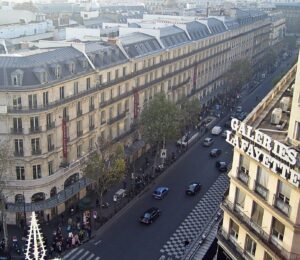In the 1850s, Napoléon III tasked Baron Haussmann with creating new roads and buildings for the city of Paris. The Baron met some controversy for his designs at the time, but nowadays we can’t imagine Paris without its famous façades. Furthermore, it only took seventeen years to build! Here is a look at the gigantic building site that changed the face of Paris.
Bad circulation
Back in the day, the streets of Paris were quite messy. Just imagine horses and carriages and people trying to make their way from East to West or North to South with no direct roads. The streets were narrow, packed with shacks and private mansions, even the air couldn’t circulate! This stuffy atmosphere resulted in diseases that would spread (ironically) quite easily. Napoléon III put a stop to it by ordering Haussmann to build a Paris where people, trades, sunlight and the air would circulate.
Making room for modernity
In order to create the large avenues we know today, Haussmann destroyed a lot of buildings from the 16th and 17th century and created great openings in historical districts. Such designs weren’t to everyone’s liking. Charles Baudelaire, the author of The flowers of Evil, wrote poems expressing his discontent to see the medieval Paris being brought down. And some said the purpose of those openings was to help the troops repress potential uprisings more easily.
Levels of change
Haussmann meant to accommodate a large number of people in a condensed space, which is why he arranged the buildings in blocks. Haussmann made the notoriously straight facades of the buildings from cut stone, and he divided the floors according to social levels. On the second floor would live the wealthiest and under the roof the poorer. This is why there are balconies on the second and fifth floor only!
The lungs of Paris
At the time, the city was terribly lacking in parks. Haussmann took notice of it and created the four lungs of Paris: the Buttes Chaumont to the North, the Bois de Boulogne to the West, the Montsouris Park to the South and the Bois de Vincennes to the East. Small squares were created everywhere so that every Parisians would have some greenery near his home.
From 1853 and 1870, Paris was an enormous building site that resulted in the twenty arrondissements we know today. Haussmann’s work had a lasting effect on the social distribution in the arrondissements. The idea of a building housing all social classes never really came to be. The refurbishments of the buildings caused a significant rise in the rent and to this day, the center of Paris remains that of the highest rents. The poorer were then made to move to the outskirts of Paris, especially the East.
Undoubtedly, Haussmann brought sunlight, fresh air and fresh water and 600 kilometers of sewers to a stuffy city and set an example of urbanism and hygiene that would impact the whole Parisian society to this very day.
Planning a trip to Paris soon? Let us design your dream Paris vacation! Request a bespoke itinerary of Paris here:




